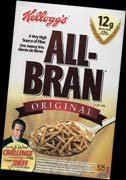The basic concept of the GI was a way to classify foods containing carbohydrates. It was to be used to compare the increase in blood glucose levels compared to a fixed amount of carbohydrates from a standardized carbohydrates source. In many cases the standard is glucose or white bread which would be given the arbitrary value of 100. From this all other foods could be assigned a numeric value and then be sorted into a classification of high, moderate or low.
From here the basic assumption was that foods with a low GI produced low levels of blood glucose because they were digested slower thus limiting the rate at which glucose was released in to the intestinal lumen and consequently into circulation.
For more than 20 years, we took this to be the truth. From these assumed acts international tables were created listing the GI values of thousands of foods. From the GI stemmed other value tables such as the Glycemic load and eventually an Insulin index. For 20 years we have been wrong!

What We Thought...

Here is what we thought we knew:
The GI is a measure of how rapidly glucose is liberated from a carbohydrate containing food and let into the blood.
- Fat can lower the Glycemic Response
- Protein can lower the Glycemic Response
- Fiber can lower the Glycemic Response.
- Different people have different body chemistries and this explains the sometimes dramatic results between different published lists.
- Amylose and Amylopectin starches will produce very different responses.
Based on the current research[4], these things seemed to be true of the Glycemic index and how it worked. However, even though researchers are very smart, they tend to only see what you put in front of their faces. They try not to over-interpret the results presented in the study (That is the job of the general public). As a result we tend not to see the entire picture. This is such a case.
 Recent research has finally investigated the direct physiological occurrences and differences between a supposed low GI and supposed high GI food.
Recent research has finally investigated the direct physiological occurrences and differences between a supposed low GI and supposed high GI food.
In this contest, researchers put to powerhouse cereals head-to-head. In one Corner High Fiber All-Bran Cereal, and in the other corner the ever popular Corn Flakes.
Tale Of The Tape
|
|
||||||||||||||||||||||||

Nutritional Breakdown Of Two Opposing Cereals

Subjects were all apparently healthy and free of any and all known metabolic disease. In a nut shell, at random individuals were asked to eat one of the two cereals. Blood was then drawn and analyzed for the rate of appearance and disappearance of glucose and insulin from the blood samples at regular time intervals (0, 20, 30, 60, 90, 120, 180 min). And just to be sure we are all on the same page, the rate of appearance is a measure of how fast something enters the blood stream and rate of disappearance is a measure of how fast something leaves the blood once it has reached an apparent peak value.
The results were interesting to say the least. Between the two cereals there was NO DIFFERENCE on the rate of appearance of glucose at the 0-20 min mark. In other words the bran cereal was digested just as quickly as the corn flakes despite the obscene amount of fiber[2]. So now we have what we would call a high glycemic response for both cereals. So why is Bran cereal considered a "Low Glycemic" Food. Well hold on to your hats.
 The bran cereal also had a greater rate of appearance of insulin into the bloodstream. This causes a rapid clearance of the glucose from the blood bringing it back down to levels that would appear to be the result of a low glycemic response. This is the first study to date to asses both glucose and insulin changes in such a short time frame and with testing periods so close together. That means in 20 years we have basically missed everything that has gone on prior to 30 minutes after a meal!
The bran cereal also had a greater rate of appearance of insulin into the bloodstream. This causes a rapid clearance of the glucose from the blood bringing it back down to levels that would appear to be the result of a low glycemic response. This is the first study to date to asses both glucose and insulin changes in such a short time frame and with testing periods so close together. That means in 20 years we have basically missed everything that has gone on prior to 30 minutes after a meal!
So why does bran cereal have such a significant impact on insulin concentrations? One of the most prominent reasons is that the bran cereal has a much higher protein content than the corn flakes.
Research has proven time and time again that when protein is ingested in combination with carbohydrate, the insulin response is greater than just with carbohydrates alone [3,5]. One of the main reasons that many people today consume a protein/carbohydrates drink after training.
More over, upon closer inspection, the type of fiber contained in the bran cereal is mostly insoluble fiber. Insoluble fiber has ben shown to have little to no effect on the rate of appearance of glucose. It is soluble fiber that has the most effect as it is the type that tends to slow down digestion where as insoluble fiber is the one that 'Keeps Things Moving' as the say.
 |
||||
 |
|
 |
||
 |
||||
If you have read my work in the past, you are well aware of my support of the progression and use of the glycemic index in the selection of food. However, after reading this research I would be weary of various items.
Now one must take into consideration numerous factors before a reliable glycemic value can be assessed. Before a reliable value can be assessed, research much be done that examines both glucose and insulin kinetics in multiple intervals that fall before the 30 minute mark after a meal.
There are of course other things to be careful of when looking at a list of values for the glycemic index.
These Would Include Factors Such As:
- Different Bands: Famous Amos and the keebler Elf both make chocolate chip cookies. But they are manufactured in completely different ways. You had better believe the will have different digestion, glucose and insulin kinetics.
- Generic Terms & World Region: Something that many people fail to realize when examining the research. A biscuit in America is not the same thing as a biscuit in England is not the same thing as a biscuit in South Africa.
- Testing Procedures: Many different researchers will use many different methods. Things like the time of day, Venous versus capillary blood samples, and 50g of total versus available carbohydrates will all have a significant impact on results.
Currently there are a number of lists the assign numeric values to various foods based on how the effect our physiology. Those being, the Glycemic Index, The Glycemic Load and the Insulin Index. Based on the research I have presented I think that researchers around the world need to take note, that not one of them on their own can be considered a reliable source of data.
 Also Check Out
Also Check Out The Revised Table Of Glycemic Index & Glycemic Load Values.
This is because it has now been established that the Glycemic response to carbohydrates is not function of the rate of appearance and disappearance of glucose. This is a complex interaction that involving digestion rates, the types of carbohydrate in the food, the amount of protein in the food and the insulin response of that food. The demand for more complete and rigorous research has been posed. We shall see if the demand is met.
References
- Foster-Powell K., Holt H.A., and Brand-Miller J.C. (2002). International table of glycemic index and glycemic load values: 2002. Am. J. Clin. Nutri. 76, 5-56.
- Hall S.E., Bolton T.M., Heyenyi G. (1980). The effects of bran on glucose kinetics and plasma insulin in non-insulin dependant diabetes mellitus. Diabetes Car. 3, 520-525.
- Nuttall PW. Mooradian AD., Gannon MC, Billington C. Krezowski P. (1984). Effect of protein ingestion on the glucose and insulin response to a stanardized oral glucose load. Diabetes Care, 7, 465-470.
- Schenk S., Davidson J.C., Zderic W.T., Byerley O.L., and Coyle F.E. (2003). Different glycemic indexes of breakfast cereals are not due to glucose entry into the blodd but to glucose removal by tissues. Am. J. Clin. Nutri, 78, 742-748.
- Van Loon, JC., Saris H.H., Veragen H., and Wagenmakers J.M. (200). Plasma insulin responses after ingestion of different amin acid or protein mixtures with carbohydrate. Am. J. Clin. Nutri. 72, 96-105
- Wolever TM, Jenkins DJ, (1981). Glycemic Index of foods: a physiologic basis for carbohydrate exchange. Am . J. Clin. Nutri. 34, 362-366

